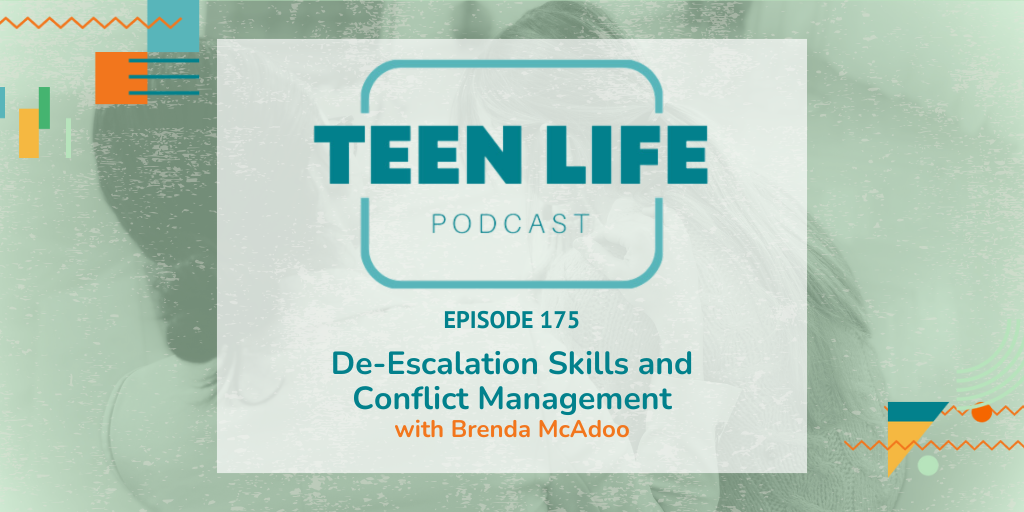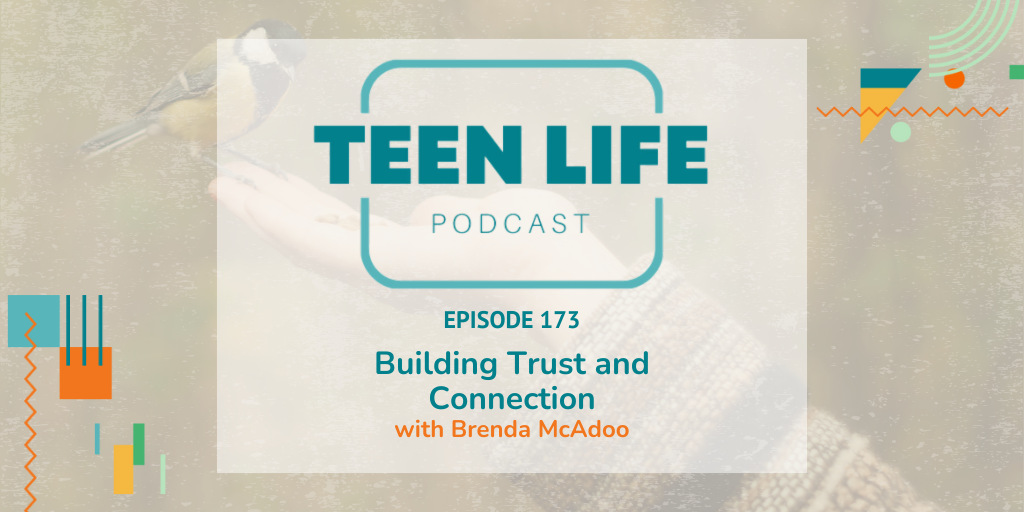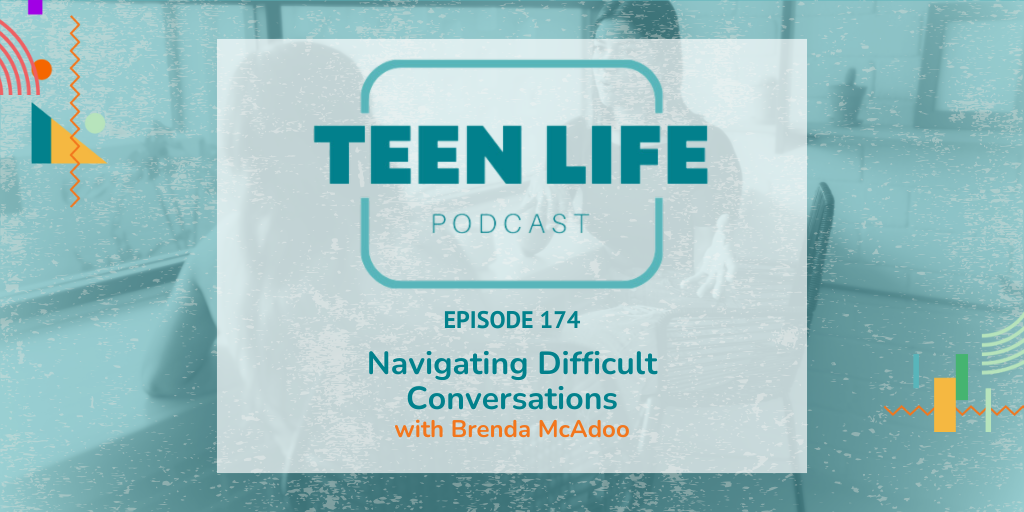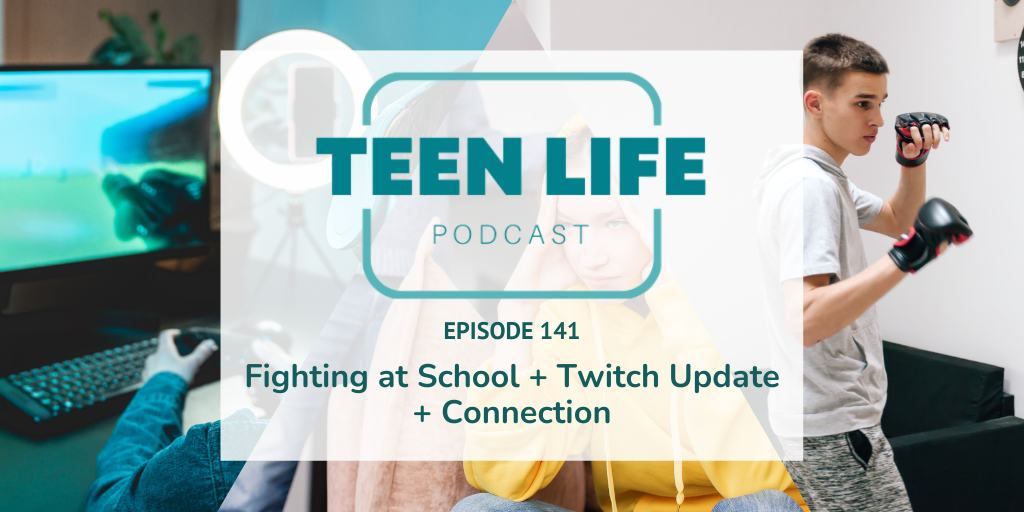Podcast: Play in new window | Download
Is It Serious? When to Step In and How to Help Teens De-Escalate
When you’re the caring adult in a teen’s life—whether you’re a teacher, coach, mentor, or parent—there’s one question that can keep you up at night: How do I know when a situation is serious enough to need outside help? Listen to episode 175 for practical tools to recognize the signs, manage tough conversations, and teach teens how to do the same.
Key Question
- How can adults recognize when a situation is serious enough to need outside intervention?
- What strategies do you use to manage your own emotions when handling tough conversations?
- How do you help other people manage their emotions and help them de-escalate?
- How can we help teens know when to intervene or call 911 or get adult help?
What We Cover
00:07 Recognizing Serious Situations and Shock Proofing
05:08 Balancing Curiosity and Intervention
06:36 Proactive Approaches in Schools
09:05 Teaching Self-Awareness and Coping Mechanisms
12:14 Managing Adult Emotions in Crisis Situations
17:18 Helping Teens De-Escalate Their Emotions
23:05 Teaching Teens to Seek Help and Intervene
Knowing the Difference Between What a Teen Says and What They Mean
Teens might repeat things they heard online or from friends, or they might say something shocking just to get a reaction.
Don’t panic—but don’t dismiss it either. The key here is to become “shock-proof.” Let the words hit without overreacting, and then gently ask questions to find out what’s really going on underneath.
Put down your phone, mute the notifications, and be fully present. Kids can feel when we’re distracted, and nothing says “you matter” like eye contact and active listening. If you’re not sure whether a situation is serious, here’s a sign: if a teen is emotionally out of control and can’t regulate themselves—even after 90 seconds—and you can’t calm them either, it’s time to get outside help.
Proactive > Reactive
It’s always better to be proactive than reactive.
That means building a support system before a crisis happens.
Do you have a good relationship with the school’s SRO (School Resource Officer)? Great—lean into that.
Learn the signs of common disorders, keep resources on hand that you can recommend, and stock your office or classroom with stress balls and fidgets.
Teach teens to recognize their own stress signs and practice de-escalation tools before they hit their limit—like punching a pillow, squeezing a soft ball, deep breathing, or simply saying out loud what they’re feeling.
Give them the language to describe what’s going on inside: “My heart’s racing,” “My fists are tight,” or “I feel like I’m going to explode.”
But What About You?
We can’t help teens manage their emotions if we’re falling apart ourselves. So let’s talk about what to do in the heat of the moment.
Start by recognizing your own signs—physical and emotional. The Reticular Activating System in your brain wants to confirm whatever you’re already feeling, so if you’re already frustrated, you’re likely to interpret everything through that lens.
That’s why identifying your triggers ahead of time is crucial. When you feel a reaction coming on, take a beat. Literally—count to three, take a breath, do some box breathing or a 5-senses grounding exercise. Even counting backwards by sevens can break the spiral.
And remember: after about 90 seconds, you get to choose whether or not to stay in that negative emotion. Model for teens what it looks like to be a calm, non-anxious presence. That doesn’t mean pretending everything’s okay—but it does mean showing them healthy ways to cope and come back down.
Helping Others De-Escalate
When a teen is in emotional distress, your job is simple: stay. Don’t abandon them. Even if they say they want to be left alone, stay nearby and show them they’re not alone.
Use distraction, humor, a question out of left field—anything to break the emotional momentum. Re-orient the space by moving to another room or having them sit somewhere new. If it’s appropriate and you have that kind of relationship, offer a hug or a hand on the arm. Sometimes, something as small as clapping your hands and saying, “Hey, I’m right here with you,” can interrupt the spiral.
These are the moments that matter. Are you willing to step into the mess with them? Because kids are worth it.
Teaching Teens When They Should Intervene
We’re not the only ones navigating these moments—our teens need tools to know when they should speak up, step away, or get help.
Teach them that they have three options:
- Walk away
- Intervene
- Get help
Help them understand when emotion tips into “out of control”: when someone can’t be talked down, can’t tell the difference between friend or foe, or when a situation turns violent beyond just pushing. When that happens, their job isn’t to fix it—it’s to find someone who can.
Let’s give teens the confidence to trust their instincts and the tools to make safe, smart decisions.
Some Last Thoughts
Big emotions aren’t the enemy—being unprepared is. With awareness, some practical tools, and the courage to step in when it matters, we can be the steady presence teens need in their stormiest moments.
You don’t have to have all the answers. You just have to be willing to stay, ask questions, and model what it looks like to keep your cool when things get heated.
And hey, if you can do that, you’re already doing more than you know.
Have a question or a topic you’d love to hear about? Reach out on social media or email us at podcast@teenlife.ngo.
Read Episode Transcript
Karlie Duke 0:07
Music. Welcome to the Teen Life Podcast, where we explore your questions to help you make meaningful connections with teenagers, because no teen deserves to feel alone. Today, we are wrapping up our series with Brenda McAdoo and Brenda, we’re just so thankful that you’ve taken the time to share your wisdom with us. I know me and you know have really benefited, no doubt, from this conversation. And today we’re wrapping up talking about kind of more handling crisis and conflict,
Brenda McAdoo 0:38
which is a great topic. Everybody needs it, yes.
Karlie Duke 0:41
And so if you’re out there listening, whether you work in a school or not, but I feel like, especially for our school people, this is going to be a beneficial conversation. So the first question that I have is, how can adults recognize when a situation is serious enough to need outside intervention?
Brenda McAdoo 0:59
Yeah, absolutely. I think there’s a difference between dealing with this with what kids say, but also dealing with this with what kids do, because I think we talked about in a previous episode about being shock-proof, right? Well, lots of kids will say things right to for shock value, or because they don’t know what the consequences are of what they’re saying or how it’s going to hit adults. Because adults have a vast amount of experience where we have dealt with trauma, we’ve dealt with pain, we’ve dealt with loss, we’ve dealt with suicide, we’ve dealt with a million things, right? And so we take that experience and put it on to what kids say, but they don’t, they don’t have that as a backdrop to the things that they say they’re going to repeat something they heard on Instagram or YouTube, or they’re going to retell a joke, right? That just doesn’t it’s not funny to adults because there’s some morbidity to it, right? And we’re seeing now a lot of kids with jokes that are what adults would consider inappropriate or morbid, right? But it’s they think it’s funny, and so we have to remember sometimes we’ve got to differentiate between behavior, right, that’s actually going on in a kid and the things that they say so being shock-proof first, because we’re trying to determine, are they saying something that they don’t understand, or just for shock value, or is it something they really feel? And that’s a hard thing, I think, for adults, especially you know, whether it’s your parent or you’re in the school dealing with kids, you never want to dismiss what a kid says For the reason that it might be, you know, they might not understand, or it might be shocking. We never want to dismiss and we don’t want to. I mean, especially maybe it’s think about as outrageous, or say, Oh, it’s just because they’re being dramatic. Do we have kids that are dramatic? Absolutely, right? Absolutely but can we differentiate, I think, between a kid being dramatic or something terrible happened to them, they don’t know how to bring it up or discuss it, so they might tell you the really hard thing that happened to them as an aside or almost with a laughing voice or a manner, because they’re not sure how you’re going to take it. Am I going to be believed by the adults who care about me? Am I going to be made fun of all those things? So I know a family years ago whose daughter was sexually assaulted and she came to tell her parents, and they didn’t believe her. That caused them hurt and grief in that family for years, right? So can we differentiate because she said it with a kind of a laughing voice, and because she didn’t know how to talk about it or what to say, and so they just dismissed it and thought that she was just trying to get attention. And so your question, right? Begs like, do we? Do we find some balance in how we talk to kids? And I’m going to bring it back to what all of our superpowers ought to be, is being curious. Can we ask questions? Can we give somebody like, put down your phone. Put down whatever you’re doing, right, whatever it is. Lots of times kids tell stuff when they were driving the car, because they’re not having to look as straight in the face, right? They’re looking forward. So are we. But can you pull over? Can you get to the house and then have that conversation? And if you’re at school, it’s in the passing period, or it’s right before the kids are going out to sports or for the day, and so then can you take the time to come back to them and be able to say, I really do want to talk to you about this. And I ask questions, not that are, you know, confrontational or judgmental, but questions that are truly open and then curious about what they’re going to say, because when kids give that information, especially in the words, right. Right? They probably are asking for your help. They might say it like a statement and act like they don’t need your help, but that’s the cry for help. And so we do have to be able to be responsive in those areas. And then I will say in the behavior, right? How do we determine when we see certain behavior, whether or not we need to intervene? That I think is more important right to think about so where kids are emotionally out of control and they can’t they can’t control themselves, and you can’t help them, that would be a clue that you need to get help outside, outside of your counselor session, or if you’re a counselor at a school or a teacher, student relationship, or even a parent, when emotions are so out of control that they either the crying can’t be helped, or the anger can’t be helped, and it doesn’t diminish. There’s there’s something about and there’s a 92nd rule so open effort runs through your body. You know, you get triggered, or you get angry, and it runs through your system that those chemicals that hit your brain run through your system about 90 seconds. If you have it beyond the 90 seconds you’ve chosen to retain it. So because of that, if they’ve chosen to retain it, or they can’t control retaining right the anger or the high emotion, and you’re not able to help them with any kind of de-escalation techniques or even just the your presence or that type of thing. Then if that happens again and again, then you probably do need help outside you. That does not mean you know you need to go to a doctor and the police and like all that first, but it needs, you need to be willing, right, to talk to other people, to learn about it, to get some resources, because you don’t want to wait too long until you have to take one of those steps, right? You’re forced to. So I think anybody who deals with teens, can we be proactive before we’re forced to be reactive?
Karlie Duke 7:07
What does that look like? You’re saying proactive? Is that, like, I’m trying to think in a school setting, is that going to the police, or is it maybe just pulling in another adult so that you have some backup? Like, do you have any thoughts on what that would practically look like,
Brenda McAdoo 7:21
Yeah, I think, well, our schools, it kind of depends on your relationship with the school resource officer, right? There’s some places where they are so integrated with the counselors and the teachers and the kids that they’re a known, you know, quantity, and they’re an adult that cares about the kids, right? That that absolutely
Karlie Duke 7:40
they’re not going to be seen as a threat as much as a resource.
Brenda McAdoo 7:44
And so, I think that a little bit depends in the schools about what that relationship looks like. But they are always a great resource. But there are tons of other resources, whether that is, you know, learning about disorders, whether it is trying to figure out where the places where I can go to get help for kids that have emotion. Do you start having in your office, stress balls? Do you have start having fidget things? Do you, I mean, are you the teacher, counselor, person that has the ability to like pivot to something else? And I think that’s do we? Do we have the ability to not always deal with the kids the kids the exact same way. Well, if you can’t get control of yourself, then you’ve got to go to the principal, or I’m going to call the police or whatever. Can we have some steps that we can walk through with kids to give them the opportunity to regulate their own emotions and get back in a good place, right?
Karlie Duke 8:35
I actually had a kid in one of my well, he wasn’t in my group. He was talking to the counselor right after my group, and he asked the question. He said, Do you have something safe I can throw? And I was like, what a good question. And she was distracted, and I was like, this isn’t my office. I’m not about to hand you something to throw. But I was like, he recognized in that moment, Yeah, but you’re right, if that’s different than a kid just picking up something and throwing it, then being like, Hey, I feel like I need to do something with my body, yeah. But can we give them safe things to do 100% when they feel that way? And can
Brenda McAdoo 9:04
we teach him to be self aware, to ask the question, I love that he was self aware enough to ask that, right? He recognized I want to hit something. So now there’s a wall, there’s a person, right? Do you have something else I can throw that’s safe? And he’s probably been given that language from people who love him, right? So we have to be that for the kids. So that’s like, one of those, you know, squish balls, right? That just never break and they can’t hit anything. Or it’s the, you know, the little nerf, whatever. So, I mean, there’s, there are so many things that kids that can learn to do to help regulate themselves. So, you know, you get a little bit older as a teen, as an adult, and then you’ll be thinking through, like breathing and sensory things and all those things that we do to kind of manage our emotions, right? But, man, could we have those things ready for kids, especially in the school setting or in the home?
Nino Elliott 9:57
So how I’m gonna back up a second. And I know we’ve talked about it prior to this whole 92nd rule. Is there a way to make that overt to a teenager, or is that something that we just need to cognitively know and watch? Are they? Are they self aware to use that expression enough to know that if 90 seconds, they go this pivot this way or choose this way. Is there a point in time where we can just say, Dude, you got 90 seconds what kind of decision you’re going to make, because after that is going to make a decision on what I get to do or have to do. Does that make sense?
Brenda McAdoo 10:34
I think giving kids language around it to be able to talk about it and not be like when they start to get mad. So you can teach kids language around being self aware, right? That’s fantastic. Like the kid asking you have something safe for me to throw being self aware, but the other piece of it is actually being aware of what’s happening in your body. So with my own kids, I would talk about, okay, you start to feel yourself get angry. Where do you feel it? Because not everybody feels it in the same place. So I feel it right under my neck, and I start getting there’s warmth first, and it spreads, and if I don’t recognize that, so some people feel in the pit of their stomach, some people feel tension in their hands and their shoulders, like there are different, yeah, different areas where people feel the physical effects of the chemicals hitting your brain and you getting angry or distressed, or whatever the strong emotion is, yeah. So I think if we can teach kids, how do you recognize in your body what’s really happening, and can you do that to be able to then take a technique, right, some sort of coping mechanism, to get you through the 90 seconds.
Karlie Duke 11:46
Okay, so pivoting a little bit. You already mentioned, managing emotions, de escalation, so especially for maybe because I think part of this is, if you’re an adult and you’re in a situation where emotions are high, you’re not only dealing with their emotions, you’re also dealing with yours. So if you had to step in or you’re upset, or something happened with the student that you care about, and now not only are you trying to be in the situation and help them, but you have to think through Wait, I’m upset or I’m angry or I’m tense and stressed. So how can do you have any practical tips for helping adults manage their own emotions when they’re in those situations?
Brenda McAdoo 12:27
Yeah, I think that recognition is really key for adults. We should be able to recognize those physical aspects of the high emotion, but I think we also need to recognize what it does to us emotionally. So that’s what it does to us physically, right? So we need to be able to be able to recognize that, so we can see it at the very beginning, there’s something called a reticular activating system. I know there’s a big word, we’re just gonna call it RAS okay, because it doesn’t matter what the science is, but what it does is it amplifies your negative feelings, and it’s a protection, right thing, and so it makes you hyper aware of the things that confirm the negative emotion that you just experienced. I’ll give you an example for an adult. So we’re in a meeting and we’re sitting around a table with some other people. We start to give our opinion about whatever topic is at the table, someone interrupts us, they give their opinion. I’ve now been triggered because I’ve been interrupted. I didn’t get to finish my story. My voice wasn’t heard. All the things, right? So even a small thing like that. So I’m triggered. Now what I begin to watch for is, Does nobody care about my opinion? Am I not want it here at the table, and I’m looking for way. I’m looking for confirmation for how I’m beginning to feel about it. Oh, interesting. So what happens to me is, then when nobody looks back at me or says like, Oh, you got interrupted. Finish your thought, right? Nobody says, finish your thought to me. So now I’m like, Oh, well, nobody wanted to hear me, so not only did that person interrupt me, so now they’re the aggressor, right? So then I’m watching them. Well, they never looked back at me, or they did. They gave me a side eye. I’m just looking for confirmation of how I feel, because that’s what my brain’s doing, right? So can we figure out, can we identify those times where you could put a stop to those things, right, to the continuation of the negative feelings? And that’s the beginning, knowing what happens in your body, and then recognizing if you’re having you know that type of thing RAS happened to you. But then the next piece is, okay, then what do with it? Right? Because, okay, I can recognize it. I can even know I’m starting to feel bad, and then it’s getting worse, right? Because of what I’m experiencing, I’m gonna plot against this. But how could I really make it better, right? So here’s a couple of things. Identify what your triggers are ahead of time, like think about them. What things really bother me? Me so I don’t like diagonal walkers, okay? Because they’re intentionally walking diagonal across the street, and it’s taking twice as long. They could go straight across, and I could go passing my car quicker. I’m impatient. I know that about myself, right? So diagonal walkers irritate me, all right? So, but if I know that, I know it’s just a thing. But if I know that about myself, when somebody starts to go diagonal across the street in front of me, then I turn on the music, I talk about something else, I go, I’m not focusing on them, right? To be able to lessen that trigger. Yeah, and so there are things that we can do, even for little triggers. Now, a lot of us have much bigger triggers, right, because we’ve been hurt before. So on those things where it’s something bigger, we have to be self aware. We’re going to have to choose space. I’ll tell you what I mean about that. So choosing space gives you that moment before you react that allows you to respond to people rather than react. So lots of times that’s taking a breath, somebody says something sassy to you, or they say the one thing, like lots of people don’t like to hear the word no, right? Kids don’t like to hear the word no, but if they say something, you know in that if you can just give yourself a little bit of space to consider your response, that really helps. Not everybody is good at that, and so if you’re not intentional enough to give yourself space, you might want to practice inside your head, naming the emotion that comes up for you. Okay, so naming something actually gives your brain something else to do. And it’s like counting backwards from 100 by seven, it gives your brain something else to do. So any of those techniques, lots of people like will count to three, or hold your breath or do the four corner breathing. There are tons of things you can do. It’s the same sort of things that we do to help people soothe themselves when they have anxiety, right? So Name five things in the room you can see four that you can hear three, right? So there are all these great techniques. They work for high emotion too, because it gives your brain something else to focus on in that space. Just distraction doesn’t work. But if you actually give your brain like that moment to think about something else, then sometimes it can for people.
Nino Elliott 17:35
Because we talked about that 90 second deal earlier, that’s we meant that in the context of teenagers, that’s just as true for an adult, Oh, right.
Brenda McAdoo 17:42
Percent, yeah. And, and for teenagers, they might not be the one choosing after that, because maybe the emotions away. For them, adults get to choose after the 90 seconds whether they’re going to continue the strong emotion or not.
Nino Elliott 17:54
So again, I’m going to back up to another point you made, and this is probably hard in the moment, but if we can be curious of why did I trigger what was it and then start to try to figure that out, be a detective, learn those things, because once we do that, it’s much easier to help someone else when in their distress or in their whatever that they need to figure that out.
Brenda McAdoo 18:18
Yeah, being the non anxious presence, yeah, if you can find calm in yourself, even in times where you’re distressed, when there’s a distressing event, if you can maintain some semblance of self awareness and calm, you can help other people. But if you let yourself get consumed by the high emotion, then you’re not any use for other people, and especially like as adults, we’ve got to be able to do that so that we can help our teens regulate themselves.
Karlie Duke 18:44
What I think sometimes adults put pressure on themselves too, is that I have to pretend like I’m fine and move forward and maybe even not acknowledge it. And when we’re talking to teenagers, especially, you have an opportunity to model for them, hey, maybe you even say hey, that I’m a little triggered right now, or I’m feeling tense, and so I need a minute to take a deep breath before I can continue this conversation. And I think sometimes we see that as a weakness, but really, you’re showing that teenager and you’re modeling, here’s how you can do this. well.
Brenda McAdoo 19:15
yeah, I love that word, like, don’t pretend, right? Don’t pretend. Everything’s okay, because then you’re modeling that to them. Now we have to pretend everything’s okay, all right. Well, the other thing is the going cold. Some people will go like, Okay, I’m not gonna show any emotion. Well, that’s not good for because then they think it’s not okay for them to show emotion to you. And that’s the opposite of what we want for our kids, like we need for them to be able to be safe to show emotion, and that’s what being curious, right? Helps do that,
Karlie Duke 19:45
okay, so in the context of teens, so that is how we can help de escalate ourselves. How can we then move on to helping them do that for themselves and de escalate their own emotions?
Brenda McAdoo 19:57
Yeah, so de escalate. Being helping other people de escalate their emotions a little bit trickier, right? Because we’re not in their head like for at least for ourselves. We’re in our head, but not in their head. But you can do some things that are soothing to other people, and I would say for for teens, don’t abandon them. Man, first thing, right? Being present. That’s what teen life’s all about. Can we be present for kids? Well, when they’re in distress or high emotion, sometimes we’re like, man, you just need to go in the corner and sit or go to your room or but that’s not what they need. They need us to be present, right? And then to help them regulate it, so if for ourselves, being able to give our brain something else to think about is true for them as well. So asking questions, not that are directly about the event that triggered them, but questions around it, so kids upset because they got left out right they see an Instagram post all their friends are at whatever event they were not invited. Okay, so that’s their event. You’re with them, and they get really, really upset. They either get angry, they’re throwing things there, or they’re crying, whatever it is. Then made the questions around, what would you like to do with your friends, if at a later date, like again, just thinking about anything else, or which of your friends are you missing out the most on being with anything that’ll kind of be you don’t want to go to a totally different topic, because then it dismisses why they’re upset. Yes, that’s good, but you want to be around it so getting them to think or talk about something else, if they are not capable of that, because sometimes teens are not capable of having conversation when they have really, really high emotion. Then sometimes it’s just a being quiet, but being with them again, depending on the situation, if you’re a parent, right, then a touch, depending on the kid. I had, one that doesn’t want to be hugged, but others that want to crawl in your lap, right? So you gotta know, you gotta know your kids. But as a school professional, in doing that, then you can use a little bit of distraction. So what’s true about super high emotion when it consumes a teen or it consumes an adult, is that sometimes outside stimulation can break, can break that so it could be just as easily, like clapping your hands together, but saying something soothing with it. Like, I know that seems weird, but like, if you have a clap and you’re like, Man, I really want to be here for you, but again, like that noise right then can disrupt their whatever emotions going on. This is very true. I did suicide prevention for a long time and talked on suicide hotlines to people. And one of the things when people are getting close to, you know, thinking about that, if you can distract them, it distracts that process in their brain, so then they have to rethink about it, right? So it gives you time to talk to people and give them hope. So anybody with really, really high emotion or distraction in that area can can help. The other things that might be really good to do with teens is to reorient them somewhere else. I know that seems weird, but like when I forget things and I’m like, Man, I would I come in the room for you’ll go back out the doorway and then come back in. Sometimes you remember, and it gives your brain that reset. So if the kid is in the hallway and they’ve just gotten in a fight, sometimes then going into a classroom or into the counselor’s office, or reorienting where they are will give them the ability to then reorient what’s going on inside. I don’t know why you know the science behind that, but it’s just true, and I’ve seen that work for people. There’s lots of little things. This begs the question, though, are we willing to step into those spaces, man and just kids are worth it, and so that being willing to find what works is a lot of trail, trial and error.
Karlie Duke 24:03
That’s good. Okay, kind of to wrap up. You’ve talked a lot about how we can help and how we can step in, but the reality is that adults aren’t always there, and there are going to be times that our teenagers are in the middle of friends are in crisis, or they’re in a hallway and there’s a fight, or they’re I don’t know, there are lots of situations where our teens are by themselves without an adult. So do you have kind of as a final push? What can we tell our teenagers so that they know, hey, here’s when I need to get help, or how I know if I should intervene or not?
Brenda McAdoo 24:38
Yeah, I think giving them the confidence that they can make that decision super important at the beginning, right? So you can tell them, hey, if we’re not there, there’s no adult there. You have the ability to make a decision, but there are two decisions, right? You either intervene, well, I guess our three, you walk away, right? Yeah. So. You walk away, you intervene, or you get help. And I think to be able to differentiate between whether or not I get help from an adult or somebody else, or emergency services or whatever, or whether I can intervene, we need to teach them to recognize when emotion tips over into uncontrolled so lots of kids yell, scream, swear, throw things right, yes, but there is a point when they are no longer in control of what they do. And I think when I’ve talked to my kids about that, in recognizing that in their friends, whether or not they can actually like, hey man, like, let’s just go get a, you know, Slurpee. Or, hey, let’s just leave this, you know, stop talking to them. We can walk away. You can intervene in things. When things are under control, when they’re out of control, it’s better to get help. And so the fine line there is when someone no longer recognizes who their friends are and who the foes are.
Karlie Duke 26:00
They’re swinging no matter who’s
Brenda McAdoo 26:02
Yep, they’re swinging no matter who’s coming. So can we recognize when my friend doesn’t differentiate between that we’re friends or not, or that they’re just angry at everybody? And you know, I think that when kids come up to a fight, you also need to recognize, has it gone past pushing right? Because if they’re already punches, or there’s several people involved right, that might be beyond what you can intervene in. Now, if you’re captain of the football team, you might still intervene in freshmen who are tussling and again, a lot of it depends on your force of personality as well. There’s some people who are so well liked, everybody wants to do the right thing for them, right? But it if you’re just in a situation where you don’t have that equity, then I’ve told my kids like, you have to recognize when you’re no longer going to be helpful to them, and the best way that you can be helpful is to get an adult or get help in those spaces. And it’s okay to do either one, you’re still helping that person, right? Because you don’t want them to get to the point where they hurt themselves or hurt somebody else, because there’s some things you can’t come back from, right? And I’m like, if you can get help for your friend before they go past that, then you’re helping their whole life.
Karlie Duke 27:22
Yes, that’s good. That is good. Well, thank you again, Brenda, for everything that you’ve talked about and walked us through and just using your experience to help our listeners. And if you are listening, we hope that you are already subscribed to the teen life podcast, but you can subscribe on YouTube, wherever you listen to podcast, and make sure you come back next week for more questions and topics covered to help you connect with teens.
Links & Resources:

Karlie Duke
Communications Director

Nino Elliott
Executive Director

Brenda McAdoo
Special Guest
Nino Elliott | Executive Director
Nino is the Executive Director for Teen Life, driven by a deep passion for supporting and empowering teens. With a Bachelor’s in Youth and Family Ministry and a Master’s in Marriage and Family Therapy from Abilene Christian University along with time spent working as a pastor and as a fundraiser, he brings a wealth of knowledge and experience to Teen Life. Committed to fostering positive relationships and creating meaningful programs, Nino is dedicated to helping young people navigate life's challenges and discover their potential.
Brenda McAdoo | Special Guest
Brenda spent 24 years as a special agent for the FBI, investigating crimes against children, violent crime, and organized crime. She served on an organized crime task force that investigated groups committing extortion, kidnapping and murder for hire. She was a member of the FBI crisis negotiation team from 1998 to 2020, including serving as team leader for seven years. She trained law enforcement officers in crisis negotiation skills both here and abroad, and she was a certified federal mediator for the U.S. Department of Justice from 2007 to 2020. And now, she’s shaping future agents, officers, and servants through an online undergraduate criminal justice program at ACU.
(excerpt, https://acu.edu/2021/06/30/on-a-mission-former-fbi-agent-heads-new-online-criminal-justice-program-at-acu/)
Karlie Duke | Director of Communications
Karlie has always had a heart for teenagers. Through her role at Teen Life, she loves to showcase the amazing stories coming out of Support Groups, but she is especially passionate about helping adults and teenagers find connection. Karlie has a BS in Communications with a minor in Family Studies from Abilene Christian University.












